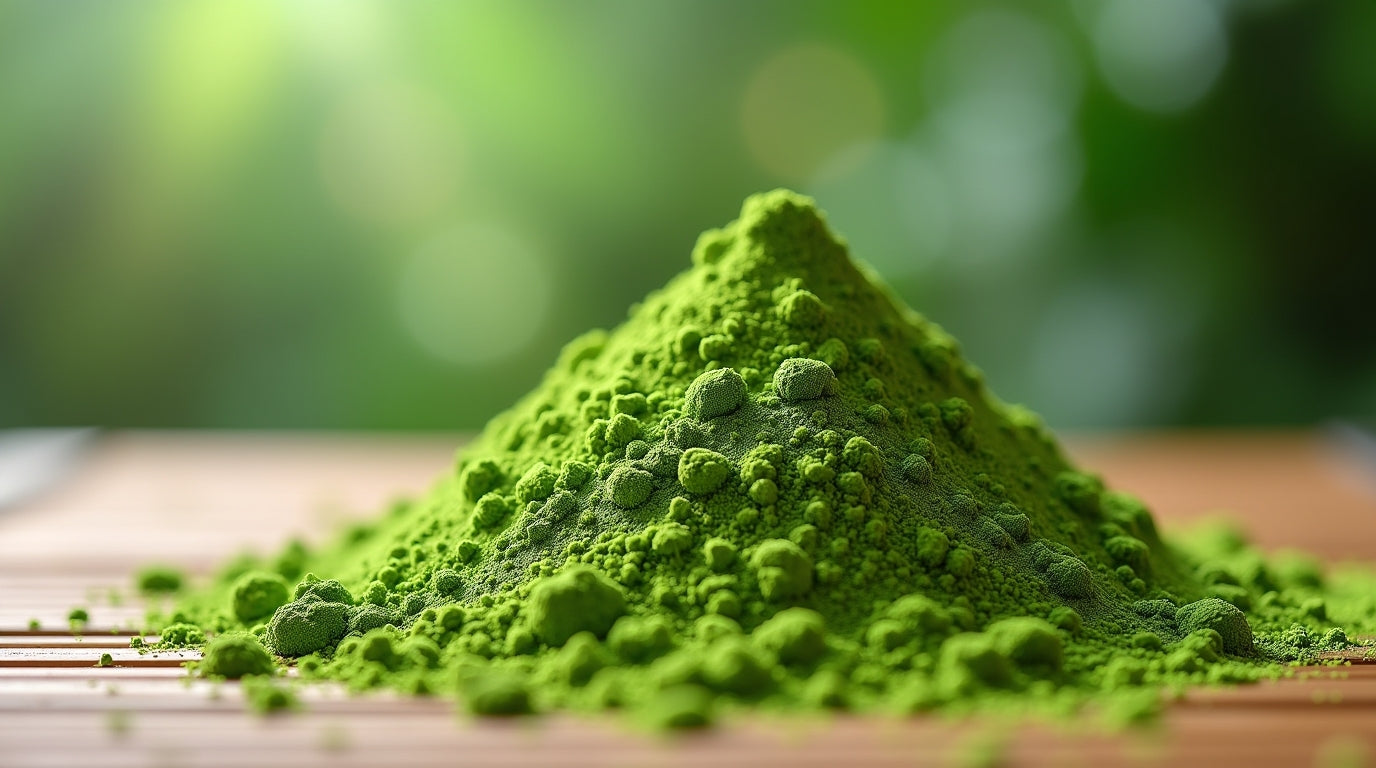
What is Inside Matcha: The Complete Guide to Nature's Most Powerful Green Superfood
Matcha has become one of the most celebrated superfoods in recent years, but many people wonder: what is inside matcha that makes it so special? This vibrant green powder contains a remarkable array of compounds that work together to provide exceptional health benefits and unique sensory experiences. Understanding what's inside matcha helps explain why this ancient Japanese ingredient has captured the attention of health enthusiasts, culinary experts, and chocolate makers worldwide.

What is Inside Matcha: The Core Components
Catechins - The Antioxidant Powerhouse
The most significant component inside matcha is its extraordinary concentration of catechins, particularly epigallocatechin gallate (EGCG). These powerful antioxidants are what give matcha its reputation as a superfood. Unlike regular green tea, matcha contains the entire ground leaf, resulting in catechin levels that are 137 times higher than typical green tea varieties.
Catechins work by neutralizing harmful free radicals in the body, potentially reducing cellular damage and supporting overall health. The concentration of these compounds inside matcha is so high that just one serving can provide the antioxidant equivalent of ten cups of regular green tea.
L-Theanine - The Calm Energy Compound
Another crucial element inside matcha is L-theanine, an amino acid that creates matcha's unique ability to provide alert calmness. This compound works synergistically with caffeine to produce sustained energy without the jittery side effects often associated with coffee consumption.
L-theanine promotes the production of alpha brain waves, which are associated with relaxation and mental clarity. This is why matcha has been used in Japanese tea ceremonies for centuries – it creates a meditative state of focused awareness that's perfect for contemplation and mindfulness practices.
What is Inside Matcha: Nutritional Profile
Chlorophyll - The Green Life Force
The vibrant emerald color that defines matcha comes from exceptionally high chlorophyll levels. This green pigment is what's responsible for photosynthesis in plants, and when consumed, it may help support detoxification processes in the human body.
The chlorophyll inside matcha is particularly concentrated because the tea plants are shade-grown for several weeks before harvest. This shading process forces the plants to produce more chlorophyll to capture available light, resulting in the characteristic deep green color and enhanced nutritional profile.
Vitamins and Minerals
Matcha contains an impressive array of vitamins and minerals that contribute to its superfood status. The vitamin profile inside matcha includes:
- Vitamin C: Higher levels than oranges, supporting immune function
- Vitamin A: Essential for eye health and immune system support
- Vitamin E: A powerful antioxidant that protects cell membranes
- Vitamin K: Important for bone health and blood clotting
The mineral content includes potassium, calcium, iron, and zinc, all of which play crucial roles in maintaining optimal health and supporting various bodily functions.
Fiber and Protein
Since matcha involves consuming the entire tea leaf in powdered form, it provides dietary fiber and plant-based protein that you won't get from steeped tea. This fiber content helps support digestive health and can contribute to feelings of satiety.
What is Inside Matcha: The Processing Difference
Stone-Ground Perfection
The unique compounds inside matcha are preserved and concentrated through traditional stone-grinding methods. This slow, careful process prevents heat damage that could destroy delicate nutrients and maintains the powder's fine texture that's essential for proper dissolution.
High-quality matcha, like the ceremonial-grade matcha used in Coracao's Matcha Chocolate, undergoes this traditional stone-grinding process to ensure maximum nutrient retention and optimal flavor development.
Shade-Growing Enhancement
The shade-growing process that matcha leaves undergo significantly impacts what's inside the final product. During the final weeks before harvest, tea plants are covered to reduce sunlight exposure. This stress response causes the plants to:
- Increase chlorophyll production for enhanced green color
- Boost amino acid levels, particularly L-theanine
- Concentrate flavonoids and other beneficial compounds
- Develop the complex, umami-rich flavor profile
What is Inside Matcha: Flavor Compounds
Umami and Amino Acids
Beyond L-theanine, matcha contains various amino acids that contribute to its distinctive umami flavor. This savory, almost meaty taste is what makes matcha so unique among teas and explains why it pairs so beautifully with chocolate in products like Matcha Fudge Truffles.
The amino acid profile inside matcha includes glycine, serine, and theanine, which work together to create the complex flavor that ranges from sweet and grassy to rich and oceanic, depending on the grade and preparation method.
Tannins and Astringency
Matcha also contains tannins, which provide structure and a slight astringency that balances the natural sweetness. These compounds contribute to matcha's ability to cut through rich foods and explain why it works so well in desserts and chocolate confections.

What is Inside Matcha: Quality Indicators
Color and Texture Analysis
Understanding what's inside high-quality matcha starts with visual inspection. Premium matcha should display:
- Vibrant jade-green color indicating high chlorophyll content
- Fine, talc-like powder texture from proper stone grinding
- No yellowing or brown spots that suggest oxidation
- Uniform consistency without clumps or coarse particles
Ceremonial vs Culinary Grades
Different grades of matcha contain varying concentrations of the beneficial compounds. Ceremonial grade matcha, like that used in Coracao's artisanal chocolate boxes, contains the highest levels of L-theanine and catechins, making it ideal for both traditional tea ceremonies and premium culinary applications.
Culinary grade matcha still contains significant beneficial compounds but may have slightly lower concentrations due to different harvesting and processing methods. However, it remains an excellent source of antioxidants and nutrients for cooking and baking applications.
What is Inside Matcha: Health Benefits
Metabolic Support
The compounds inside matcha work synergistically to support healthy metabolism. The combination of catechins, particularly EGCG, and caffeine may help boost metabolic rate and support fat oxidation during exercise.
Research suggests that the polyphenols inside matcha may help regulate blood sugar levels and support cardiovascular health through their antioxidant and anti-inflammatory properties.
Cognitive Enhancement
The unique combination of L-theanine and caffeine inside matcha creates an ideal environment for cognitive enhancement. This pairing provides:
- Sustained energy without crashes
- Improved focus and concentration
- Enhanced memory formation
- Reduced stress and anxiety
- Better mood regulation
Detoxification Support
The high chlorophyll content inside matcha may support the body's natural detoxification processes. Chlorophyll has been studied for its potential ability to bind to toxins and support their elimination from the body.

What is Inside Matcha: Culinary Applications
Chocolate Pairing Perfection
The complex compounds inside matcha make it an ideal partner for chocolate. The earthy, umami notes complement chocolate's richness while the natural sweetness balances cacao's intensity. This harmonious relationship is showcased beautifully in premium confections that combine high-quality matcha with artisanal chocolate.
The L-theanine inside matcha also provides a calming counterpoint to chocolate's stimulating properties, creating a more balanced and enjoyable experience for the consumer.
Versatility in Desserts
Understanding what's inside matcha helps explain its versatility in dessert applications. The powder's fine texture allows for easy incorporation into various recipes, while its complex flavor profile adds depth and sophistication to:
- Ice creams and sorbets
- Cakes and pastries
- Beverages and smoothies
- Ganaches and truffles
- Cookies and macarons
What is Inside Matcha: Storage and Preservation
Protecting the Compounds
The delicate compounds inside matcha require proper storage to maintain their potency and flavor. Exposure to light, air, heat, and moisture can degrade the beneficial catechins and alter the taste profile.
Optimal storage involves keeping matcha in airtight containers, away from light and heat, preferably in the refrigerator for long-term storage. This preservation method ensures that the valuable compounds inside matcha remain active and effective.
Freshness Indicators
Fresh matcha will maintain its vibrant color and complex flavor profile. Signs that the compounds inside matcha may be degrading include:
- Color shifting from bright green to yellow-brown
- Development of bitter or harsh flavors
- Loss of the characteristic sweet, umami taste
- Changes in powder texture or clumping
Understanding what is inside matcha reveals why this ancient superfood has earned its reputation as one of nature's most powerful nutritional ingredients. From its extraordinary antioxidant content to its unique amino acid profile, matcha offers a complex array of beneficial compounds that support both physical health and mental well-being. Whether enjoyed in traditional tea ceremonies or incorporated into modern culinary creations, the remarkable components inside matcha continue to captivate and nourish people around the world.

Claire Bennett
I'm Claire, a chocolate lover and artisan based in a small town where I run a tiny home kitchen dedicated to exploring everything chocolate. From single-origin dark bars to creamy ganache and handmade truffles, I find joy in working with all types of chocolate. I believe chocolate has a story, and I love bringing that story to life through humble, heartfelt creations.



Leave a comment
This site is protected by hCaptcha and the hCaptcha Privacy Policy and Terms of Service apply.